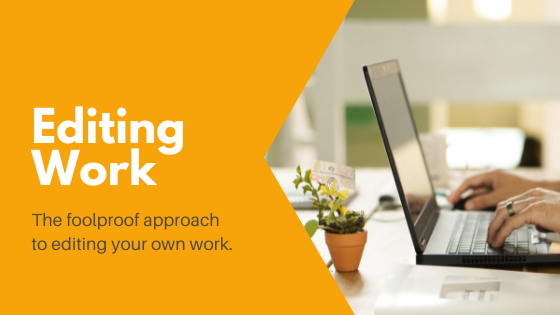Find every last mistake and typographical error with these reliable editing tips.

How to self-edit your writing: Tips for non-professionals
After a long day of brainstorming, researching, planning, and then writing copy, nothing can take the wind out of your sails more than having to edit your own work.
It’s time-consuming, it’s boring, and, frankly, it hurts the eyes. But we aren’t always lucky enough to be able to hire a freelance editor to do the work for us. You need to have the resources to pay for an editing service.
That’s when knowing how to self-edit your writing becomes really handy!
Read on for some tried-and-tested editing tips for writers.
Editing and proofreading techniques
1. Take a break.
Here’s a very simple editing and proofreading tip: When you’re done writing, take a break.
First of all, you’ve earned it! Second, your brain needs it.
Want to just power ahead and get your editing over and done with? That’s a bad idea.
You need to distance yourself from what you’ve just written before you dive back into it. After all, tired eyes catch fewer mistakes. So go for a walk, head out for some coffee, or simply sleep over it. The key to effective editing is to inspect your work with fresh eyes.
2. Eliminate distractions.
You know what they say: starve your distractions, feed your focus. What that means is work where you’re comfortable but, more importantly, work where you won’t get distracted.
Distractions come in many different shapes and forms. Your mission is to get away from them all. For example: Put your phone on silent. Log off social networking sites. And ask the kids to play in another room.
In short, whether you prefer total silence or need just a tiny bit of background noise to get in the zone, choose an environment that allows you to concentrate on the task at hand.
3. Don’t rush.
Want to know how to edit writing? Split the work up into manageable chunks.
Truth be told, you don’t have to finish editing an entire document in one sitting—especially if it’s several thousand words long. (Chances are you won’t anyway.) So tackle one ‘section’ at a time and take breaks as needed. Remember that when we’re rushed, we feel stressed. And stress affects our ability to focus.
In other words, rushing leads to mistakes.
4. Break the text down.
It’s a lot harder to spot mistakes when you’re reading walls and walls of text. In fact, it can feel pretty overwhelming. That’s why it’s always a smart idea to break large chunks of text (like paragraphs) down into individual sentences for the purpose of editing. There’s no fancy trick involved here: Simply start a new line after every sentence.
5. Temporarily alter the document’s appearance.
Have you heard of typo blindness? That’s what we call the inability to catch the mistakes in our own writing. Basically, this happens because we already know what we’re trying—or want—to say. So little mistakes don’t instantly pop out to us the way they would to a third party.
Fret not though because there’s a way to overcome this and that is to trick your mind into thinking that you’re looking at an unknown document. But how do you do that?
Here’s a copy editing secret: Change your font or background color, adjust the text’s size, or switch to a different font entirely. Those small adjustments fool your brain into believing you’re looking at something totally new.
6. Don’t rely on automatic spelling and grammar checkers.
Such tools are programmed with a limited set of ‘rules’. And even with all the latest developments in technology, checkers aren’t capable yet of understanding what’s written the way that humans can. This means:
- They don’t always catch every error.
- What they mark as incorrect isn’t always wrong.
At the end of the day, you need to have a firm grasp of grammar rules and proper spelling. Use these types of software as a starting point—for support—but don’t expect them to do all the heavy-lifting for you.
7. Work with a hard copy.
This is perhaps one of the best editing tips I can give you: Even if you’re most comfortable working on the computer, it’s always good practice to read through a hard copy. Trust me, you’ll find errors in the printout that you wouldn’t have noticed on screen!
8. Read out loud.
Want to know if something sounds awkward, ‘weird’, or disjointed? Read it out loud. The way it sounds in your head can be totally different to how it sounds when spoken out loud. This is an editing strategy you definitely don’t want to skip. (It’s what the pros do!)

9. Work through one set of errors at a time.
Here’s another one of my favorite editing tips: Don’t try to achieve everything – checking for spelling, grammar, accuracy, repetition, etc. – in one sitting. You’re more likely to miss things that way. Instead, prep a checklist of the different types of errors and work your way through them one category at a time. For example: Start with checking for spelling. Next, correct the grammar. Follow that up with proper punctuation and capitalization. And so on.
10. Feedback from family and / or friends.
When in doubt, ask for help. Aside from getting feedback on what you’ve written, family and friends bring a different perspective with them. They won’t just point out problems you might not have noticed – their thoughts will actually help you improve the quality of your copy.